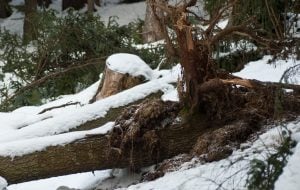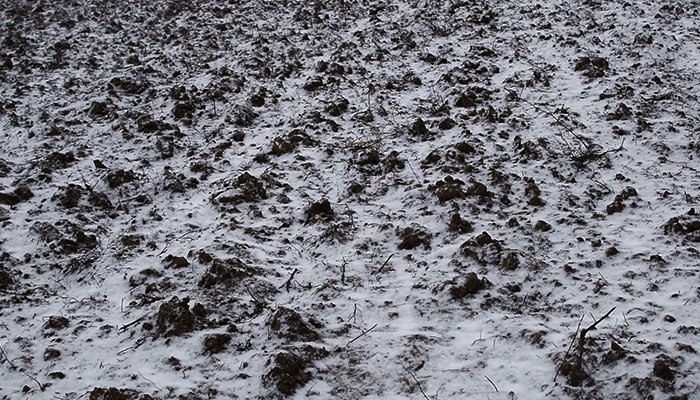Like humans, trees are largely made up of water. In fact, they are about 50% water. Since trees are about half water, it’s safe to assume that freezing will take place, even with the most cold-enduring winter trees. Many animals hibernate, or migrate south for the cold months as a means of survival. So, since trees cannot move, or hide, how do they survive the below freezing and harsh conditions of winter?
A tree’s “survival” process and preparation begins in late summer. This cold acclimation process will begin gradually, and consists of physiological changes in leaves, stems, and roots.
 Dormancy is a tree’s version of hibernation to aid in winter survival.
Dormancy is a tree’s version of hibernation to aid in winter survival.- During dormant months, winter trees will slow down all functions (metabolism, energy, food consumption, growth, etc.) similar to a hibernating animal.
- Since trees are not making food in winter, they do not need the energy typically required to feed their leaves.
- In mid-late fall when it is time for a deciduous tree to shed its leaves, a chemical called ABA (Abscisic Acid) will produce in buds. When this chemical gathers, it signals for the leaf to fall off.
- ABA is also the chemical that suspends growth – saving and storing energy that will be needed to survive winter.
- Winter trees will store food and energy to be used slowly throughout the cold months only on necessary functions.
Paul Schaberg, a Research Plant Physiologist with the USDA Forest Service’s Aiken Forestry Sciences Laboratory in Burlington Vermont, suggests that there are three basic ways that winter trees survive. All of these methods discuss how the tree keeps its living cells from freezing.
- Change Membrane During Cold Acclimation Process – The purpose of this change is to allow the membrane to become more pliable. This, in turn, allows for water to migrate out of the actual cells, and into the spaces between the cells. By removing water from the living cells, the cells shrink, allowing for more room within the cell walls (where the water was relocated to). This also helps to avoid the freezing and dying of living cells.
- Sweeten Fluids Within Living Cells – In fall, a tree will convert its starches to sugar. When this conversion takes place, the cellular fluid becomes concentrated. This concentration lowers the freezing point inside the cells. The water that remains between cells will still freeze, but since the membrane is more pliable in trees in winter, the cells are squeezed but not pierced.
- The “Glass Phase” – This is described by Schaberg as the period in which the liquid cell contents become so viscous that they appear to almost be solid. This simulation of solid form mimics the way silica remains in liquid form when it is supercooled into glass. This 3rd means of survival that winter trees undergo is triggered by the advanced cellular dehydration that results from the first two survival methods listed. This “glass phase” aids in preventing crystallization of the contents in the tree’s living cells.
By focusing only on protecting its living cells, and allowing dead cells to freeze, the tree can sustain enough energy, food, and function to get through the winter months with its living cells still intact. Dead cells are typically found in a large portion of cells within the trunk. These cells are helpful in assisting with function necessary in the warmer months (like flowing sap), but during the cold and dormant months, this function is not necessary. Since the energy and nutrients required to sustain trees in winter is much lower, these dead cells can freeze without negatively effecting the tree.
While trees do a great job of protecting themselves during their dormant months, this does not mean that the “recovery” process is easy. Depending on the harshness of winter, spring sap production and other important spring functions may be slow or delayed. Although these self-induced defense mechanisms may lead to slow recovery and/or a strenuous process when spring comes around, it is key in protecting living cells to avoid the possibility of a tree dying.
 Activity within a tree’s root system is periodic, and while they too are dormant in winter, tree roots maintain a readiness to grow independently of the aboveground parts of a tree. This means, they are predominantly inactive, but can begin to grow during winter months if and when soil temperatures are favorable. The minimum soil temperature for root growth is around 32-41 degrees F. If soil warms, or stays warm during winter, your tree’s roots may break their dormancy and become active. Typically, below ground remains safe in winter due to insulation provided by the covering of snow. This “readiness” of tree roots in winter can help to replace damaged roots, ready the tree for spring buds, and foster great aboveground growth in the following growing season. However, there is always the chance of winter root damage if soil insulation is not adequate.
Activity within a tree’s root system is periodic, and while they too are dormant in winter, tree roots maintain a readiness to grow independently of the aboveground parts of a tree. This means, they are predominantly inactive, but can begin to grow during winter months if and when soil temperatures are favorable. The minimum soil temperature for root growth is around 32-41 degrees F. If soil warms, or stays warm during winter, your tree’s roots may break their dormancy and become active. Typically, below ground remains safe in winter due to insulation provided by the covering of snow. This “readiness” of tree roots in winter can help to replace damaged roots, ready the tree for spring buds, and foster great aboveground growth in the following growing season. However, there is always the chance of winter root damage if soil insulation is not adequate.
Although trees are excellent at protecting themselves by changing and adapting during dormancy, there are still steps that you should take on your property to winterize your landscape (especially the more sensitive trees and plants). Prior to winter you’ll want to perform a number of exterior maintenance tasks to prepare your property. Now is also the time to consider fall planting. Contact Red Cedar today for your free consultation and make sure that your property, trees, and landscaping are prepared to take on snow, frost, ice, hungry deer, and the cold!


